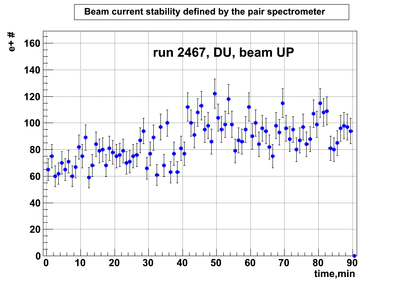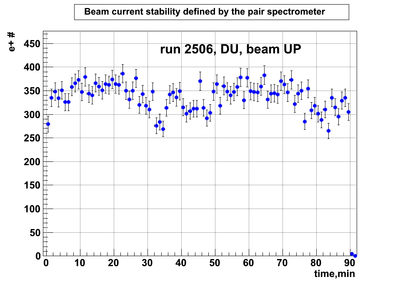Difference between revisions of "Photon flux proportionality"
Jump to navigation
Jump to search
| Line 11: | Line 11: | ||
[[File:flux_DU_r2506.png | 400 px]] | [[File:flux_DU_r2506.png | 400 px]] | ||
| − | The average photon flux increased from 90 <math>e^+/min</math> to 350 <math>e^+/min</math> and the ratio is 350/90 = 3.9. | + | The average photon flux increased from 90 <math>e^+/min</math> to 350 <math>e^+/min</math> and the ratio is 350/90 = 3.9 . |
The number of neutrons used to do narmalization, i.e. the sum of the number of neutrons in three detectors placed at 0 deg left, 90 deg bottom and 0 deg right changed as follows: | The number of neutrons used to do narmalization, i.e. the sum of the number of neutrons in three detectors placed at 0 deg left, 90 deg bottom and 0 deg right changed as follows: | ||
| Line 18: | Line 18: | ||
run 2506: SUM(0-90-0) = 2195 neutrons | run 2506: SUM(0-90-0) = 2195 neutrons | ||
| + | |||
| + | The neutron number ratio is 2195/518 = 4.2 . | ||
| + | |||
| + | That means that photon flux monitor can be used for the purpose of relative normalization. | ||
Revision as of 17:19, 10 June 2013
If we compare the photon flux from the two runs with DU target
run 2467
and
run 2506
The average photon flux increased from 90 to 350 and the ratio is 350/90 = 3.9 .
The number of neutrons used to do narmalization, i.e. the sum of the number of neutrons in three detectors placed at 0 deg left, 90 deg bottom and 0 deg right changed as follows:
run 2467: SUM(0-90-0) = 518 neutrons
run 2506: SUM(0-90-0) = 2195 neutrons
The neutron number ratio is 2195/518 = 4.2 .
That means that photon flux monitor can be used for the purpose of relative normalization.

